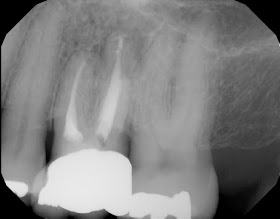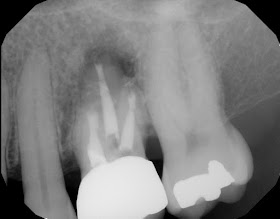"Is this tooth bothering my sinuses?"

For years patients with chronic sinus issues have asked this question at the dental office. Unfortunately, there has been a communications gap between diagnostic medicine and dentistry in this overlapping area of practice. Endodontists are experts diagnosing pulpal disease, but not trained in diagnosis of sinusitis. Most otolarygologists (ENT) physicians, and especially rhinologists, are experts in sinus diagnosis, but not trained in evaluating dental and pulpal infection, which may be a source of infection for the sinuses. Most sinus CTs are not including the teeth and rarely are medical radiologists evaluating the teeth in their reads.
In cooperation with Dr. Tim Haegen of the
Arizona Sinus Center, a division of Valley ENT, we have been able to help patients with chronic sinus issues. Many of these patients have bounced from ENT to ENT looking for answers, some have had continuous courses of antibiotics and some have had sinus surgery, only to continue to have chronic sinus issues. With some interdisciplinary education between endodontics and otolaryngology, familiarization with each other's diagnostics and terminology and the use of medical and dental CT imaging, we are working together to diagnose and treat the often time overlooked odontogenic sources of sinusitis. The use of 3D imaging between disciplines has helped to bridge the gap of communication between medical and dental specialists trying to help patients with sinusitis and dental infections.
The following case demonstrates how proper understanding of endodontic and ENT imaging, diagnostics and terminology facilitate proper diagnosis and treatment.
This patient presented to Arizona Sinus Center for evaluation of chronic sinus issues. She presented with chronic, unilateral nasal and facial symptoms, along with foul smelling nasal discharge. Nasal endoscopy was performed and findings include:
FINDINGS:
- Nasal septum - superior deviation to right, mucosa intact, no perforation or crust
- Right inferior turbinate - normal
- Right middle turbinate - edematous
- Right middle meatus - closed; edematous medialized uncinate. Tissue is pulsatile. No purulence or polyps.
- Right posterior choanae - normal
- Left inferior turbinate - normal
- Left middle turbinate - normal
- Left middle meatus - open, no mucopus or polyps
- Left posterior choanae - normal
- Nasopharynx - no masses
RADIOGRAPHIC FINDINGS:
 |
| Complete opacification of the right frontal sinus. |
 |
| Partial opacification of the R ethmoid sinuses. |
 |
| Complete opacification of R maxilliary sinus, superior septal deviation to the right, bilateral opacified concha bullosas. |
 |
| Molar #2 and #3 have periapical radiolucency (PARL), one of which is dehiscent into the maxillary sinus and buccal gingival sulcus. This may be the most important diagnostic information in the CT scan. Too often, radiologists and otolaryngologists are not looking at this part of the scan - if it is even included in the field of view. |
Following evaluation, the following impressions were recorded.
Impression:
- Nasal Obstruction
- Deviated nasal septum
- Frontal sinusitis, chronic
- Maxillary sinusitis, chronic
- Ethmoidal sinusitis, chronic
- Dental caries, unspecified
- Disturbances of sensation of smell and taste
With these radiographic findings and clinical impressions, the patient was then referred to
Superstition Springs Endodontics for evaluation and definitive treatment of the maxillary molars #2 and #3. Due to the complete opacification of multiple sinuses along with bony erosion of the medial orbital wall, the possibility of endoscopic sinus surgery was discussed. Discussion included risks of failure to treat the infection within the sinuses as well as failure to remove the source of the infection, which in this case has to include the dental source of infection.
 |
| Pt presents for endodontic evaluation of #2 and #3 following ENT identification of possible dental abscess adjacent to Mx sinus. |
Endodontic diagnosis, including CBCT, determines that tooth #2 has a prior root canal with a root fracture and extraction is recommended. Tooth #3 has a prior RCT with apical abscess - caused by a missed MB#2 canal during the initial root canal treatment. Retreatment of the root canal #3 is recommended.
 |
| Endodontic retreatment with microscope locates the previously missed MB#2 canal. |
 |
| MB#2 canal is debrided and irrigated with NaOCl. |
 |
| PostOp radiograph shows all 4 canals have been properly treated. |
 |
| PeriApical RadioLucency (PARL) seen at apex of MB root - which had a missed canal on initial treatment. |
 |
| 6 month recall following endodontic retreatment shows healing of the PARL. |
After 6 months, extraction of tooth #2 and retreatment of tooth #3 has shown periapical healing. The potential odontogenic source of the sinus infection has been eliminated. Since the Mx sinus continues to show opacification, the patient is referred back to Dr. Haegen for continued sinus evaluation and treatment.
Why See An Endodontist?
 |
| Dental Operating Microscope used by endodontists |
The endodontists at
Superstition Springs Endodontics are experts in
endodontic diagnosis and have extensive experience with
CBCT.
In addition, endodontists are specially trained to perform the most
difficult endodontic cases. Maxillary molars, most closely associated
with the maxillary sinus, almost always have 4 canals.
A common reason for root canal failure on Mx molars
is inadequte cleaning, and often completely missing the MB#2 canal.
Endodontists using an operating microscope are able to find and treat
the MB#2 (4th canal) more effectively and efficiently. Endodontist are
also trained to perform endodontic microsurgery when traditional
endodontic therapy is unsuccessful.
When endodontists
and otolaryngologists work together, they can provide the best care for
patients with odontogenic sinusitis.



































